
Oftentimes, when we think of the world of ancient Rome, one of the images that springs to mind is that of the sacrifice, the image of a priest before an altar slashing the throat of some sort of animal, the blood of which oozes in grisly flow down the sides of a white marble altar.
It’s a dramatic image to be sure, but it does not provide us with the complete facts of sacrifice in Roman society.
Today, we are going to take a brief look at sacrifice in Roman religion, what it meant and what it could entail.

Roman altars, perhaps erected as votive offerings themselves
Basically, a sacrifice, or sacrificium, was a gift to the gods, heroes, emperors, or the dead. It was not simply a matter of the ritualistic killing of animals as is our modern perception of ancient sacrifice.
Not all sacrifices were blood sacrifices, and not all sacrifices were public displays either. There were also private sacrifices.
Whether public or private, the goal was to maintain one’s relationship with the gods, the dead, etc. and this was done in different ways.
Food offerings were not only of flesh, but could also be of fruit or grain, milk, honey or something similar.
Depending upon the nature of the offering and its intent, a food offering might be part of a sacrificial feast in which people shared with the gods, both receiving their portion to consume. Alternatively, the entirety of the sacrifice might be offered to the gods to be consumed in the flames.
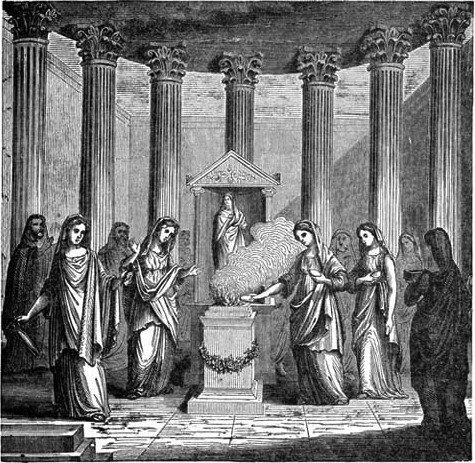
Most of the evidence for sacrifices in the Roman world come to us from inscriptions on altars which were themselves considered sacrifices.
There could be various reasons for a sacrifice such as one made in expectation of a favour, or a sacrifice that was demanded by the gods through an oracle, omen, dream or some other such occurrence. Sacrifices were also made on anniversaries, such as the anniversary of a family member’s death or an historic event, or they could be made as part of a religious festival.
Roman religion was customizable in a sense, and so the types of gifts of sacrifices could vary. They might include cakes, incense, oils, wine, honey, milk, and perhaps sacred herbs or flowers. And yes, they could also include various blood sacrifices with certain types and colour of animals being more fitting for certain gods.

A bull being led to sacrifice, the ceremony accompanied by a tibicen, or flute player.
One of the most common forms of sacrifices were those made in fulfillment of a vow, meaning that if a particular god undertook a specific action on behalf of the mortal making the request, then that mortal would carry out the promised sacrifice. Perhaps that mortal would build an altar to that god if his political campaign was successful, or perhaps a general would sacrifice fifty bulls if he was victorious on the battlefield?
When it came to the slaughter of animals as part of a sacrifice, it seems that male animals were offered to male gods, and female animals to goddesses. They had to be free of blemishes and a suitable colour as well, for example, black for underworld gods. There were also times when the animal sacrificed was one that was considered unfit for human consumption, such as the sacrifice of dogs to Hecate.
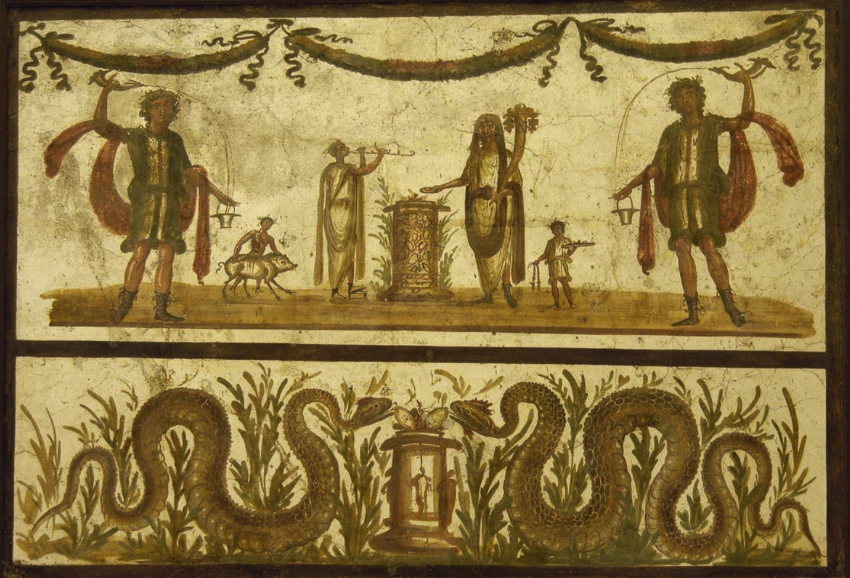
A sacrifice portrayed on a lararium, or family shrine, in Pompeii
It does not appear to have been usual for a regular citizen to perform an animal sacrifice. It was more the case that the person who wanted to make the sacrifice made arrangements for the ceremony with the aedituus of a particular temple who hired a victimarius to perform the actual slaughter. There might also have been music provided by a flute player, or tibicen, in order to please the god but also to cover up any sounds of ill-omen from the victim.
For most sacrifices, a priest would have his head covered by the folds of a toga to guard against ill-omened sights and sounds, except at Saturnalia when things were the reverse of the usual and priests performed sacrifices with their heads uncovered.
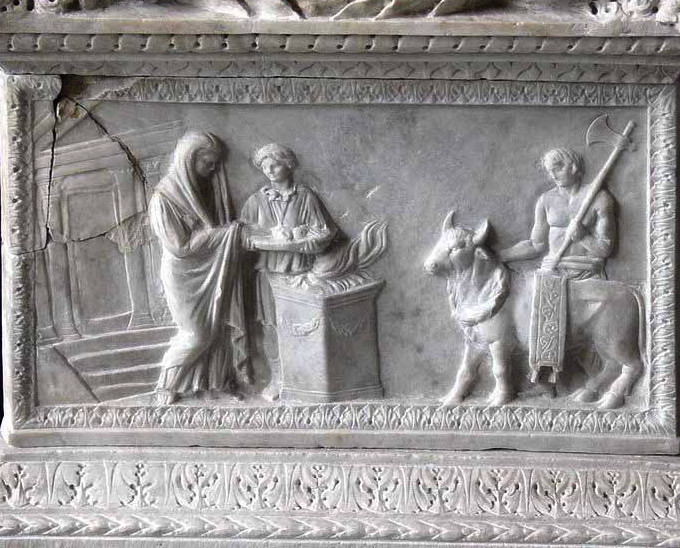
Notice the covered head of the person performing the sacrifice, and the poleaxe carried by the victimarius leading the bull to slaughter.
One might think that it was an easy thing to slaughter an animal, but it seems that the opposite is the case. Aside from trying to avoid any ill-omened sights or sounds, the way in which an animal was slaughtered was very important to Romans.
The head of the animal was usually sprinkled with grains, wine, or sacred cake known as mola salsa before it was killed. It was then stunned with a blow to the head, perhaps with a ceremonial axe or cudgel, and then stabbed or its throat slit with a sacrificial knife. The blood was then caught in a special bowl and poured over the altar.
Once the sacred deed was done, the animal was skinned and cut up. It is at this point that a haruspex might examine the entrails for messages or omens from the gods.
The remains were roasted over the fire with the entrails consumed first. Bones wrapped in fat, the preferred portion of the gods, were then burned upon the sacred fire along with other offerings such as wine or oil. If it was part of a sacrificial feast, the remaining portions were then roasted for the mortal participants.
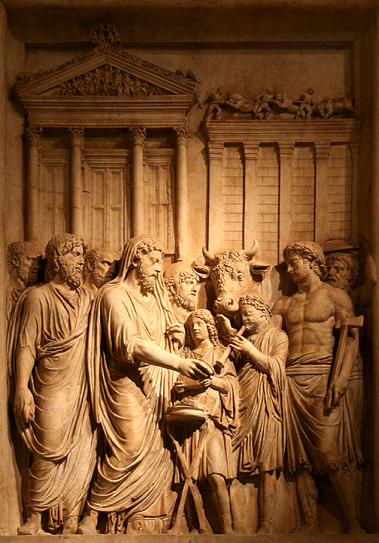
Relief of Emperor Marcus Aurelius performing a sacrifice
Blood sacrifices could be performed for different occasions that also included times of crisis, such as if Hannibal was at the gates of Rome, for the purposes of purification, or for the rites of the dead.
Chillingly, I only recently discovered that a holocaust was a sacrifice in which the victims were completely burned.
Another type of sacrifice that was well-known in ancient Rome was the suovetaurilia which involved the sacrifice of a pig, a sheep, and an ox. No doubt this particular sacrifice made for a good meal afterward for the participants.
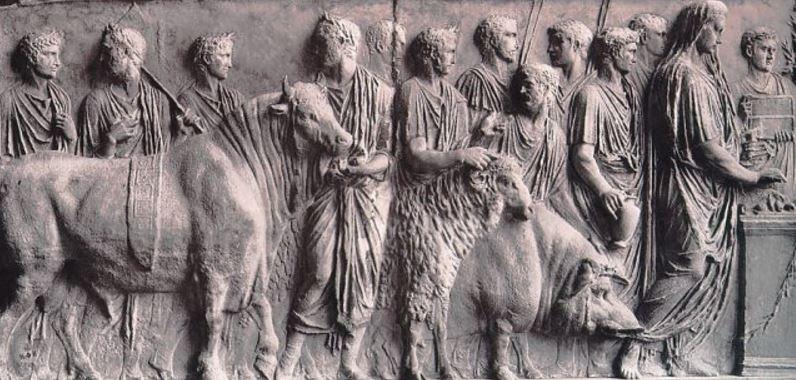
Relief of a Suovetaurilia ceremony
But what about human sacrifice in the Roman world?
It is thought that early gladiatorial combat was a form of sacrifice, but there is little evidence for regular human sacrifice over time.
It was practiced only in exceptional circumstances such as after disasters in battle. One example is in 216. B.C., after the battle of Cannae when the Sibylline Books were consulted, a pair of Greeks and a pair of Gauls were sacrificed by being buried alive in the Forum Boarium of Rome. Titus Livius (Livy) recounts the latter here:
Since in the midst of so many misfortunes this pollution was, as happens at such times, converted into a portent, the decemvirs were commanded to consult the Books, and Quintus Fabius Pictor was dispatched to Delphi, to enquire of the oracle with what prayers and supplications they might propitiate the gods, and what would be the end of all their calamities. In the meantime, by the direction of the Books of Fate, some unusual sacrifices were offered; amongst others a Gaulish man and woman and a Greek man and woman were buried alive in the Cattle Market, in a place walled in with stone, which even before this time had been defiled with human victims, a sacrifice wholly alien to the Roman spirit.
(Livy; The History of Rome 22.57.6)
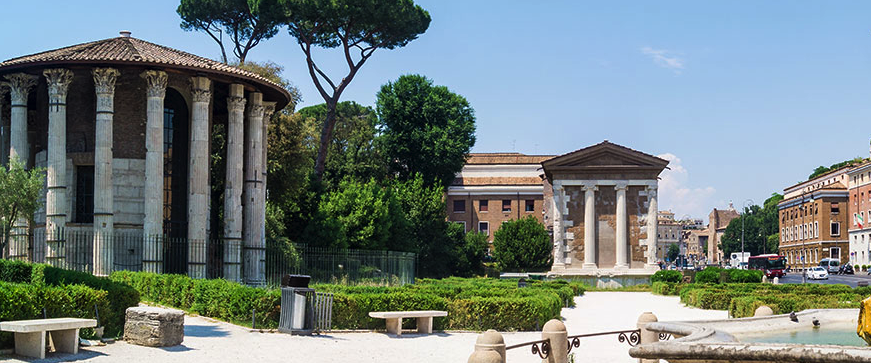
The Forum Boarium in Rome, the Cattle Market with the round Temple of Hercules on the left.
Human sacrifice was eventually outlawed by senatorial decree in 97 B.C., though the practice might have continued in some non-Roman cults for a time. It does seem that effigies or masks could have replaced actual human victims in some rites.
Whether they took place in a public forum, in one of the main temples of Rome, or in the lararium of a private domus, it seems evident that sacrifice was central to Roman religious practices.
The sacrificial offerings varied greatly from animal and human flesh, to wine, oil and incense, to other foods such as cakes, grains, flowers and more. Sacrifices could also include altars and the building of monuments.
What mattered was that the gods were propitiated and the dialogue between the earthly and divine realms was maintained and respected.
To me, Roman religion and sacrifice are crucial to our understanding of the ancient Roman world. It’s a fascinating subject that still holds many mysteries, and I hope that you have found this brief look interesting.
Thank you for reading.














Thank you for this valuable contribution to further knowledge that establishes a clear view of the beliefs during Roman times.
You’re very welcome, Mary. I’m glad you enjoyed the post. Cheers and thank you for your comment 🙂
Where did you get your info? I used this source for a school project and I want to make sure it’s reliable.
Hello Roberta. Thanks for stopping by. Glad this post came in handy for your project. Rest assured, I am a trained historian and take the sources I used seriously. The information is correct. You can find useful information in primary sources like Livy (quoted in the post), and on reliefs and other archaeological and artistic remains. If you are looking for a handy source for everyday Roman life, try the Handbook to Life in Ancient Rome by Adkins and Adkins. It is always useful and will point you to other sources. Best of luck with your studies!
hi thanks for sharing this post with us. I found it very beneficial in school.
You’re very welcome, Elizabeth! So glad you found it useful. 🙂
Do you think it likely that rigorous extirpation of the Druidic religion by the Romans was inspired by their detestation of human sacrifice? Or perhaps the Roman authorities used that detestation as their excuse to challenge and crush the Druids who were seen as a threat to Roman authority in the province of Britannia?
Thank you for your comment, Rick. Certainly the Romans had an aversion to human blood offerings (but for some exceptional circumstances), but I think you are right on both counts. Both were likely reasons for their pursuit and attempted elimination of the Druids. Normally, in hindsight, the Romans were pretty open to other cultures and religions, assimilating aspects of most from gods and goddesses, to weapons etc. But when a religious group was particularly stubborn and rebellious, the Romans didn’t hold back. The Christians and Druids were prime examples of this – they were not going to accept Rome’s authority or gods. In Britannia however, all of that blood paved the way for a long Pax Romana in which Britannia thrived and a wonderfully-rich Romano-British culture and society emerged. This is all open to interpretation, of course. But these are my initial thoughts 😉 Cheers!
Thank you, very interesting.
You’re very welcome, John. Glad you enjoyed this post!
Thanks for the post. You say that regular romans didn’t usually perform their own animal sacrifice. This has been a difficult thing for me to find any information on. Is it your take that most romans throughout the empire didn’t regularly perform public animal sacrifices of any kind? When there was a festival, did the elite basically handle the expense of the animal sacrifices? Average people didn’t line up to make public offerings themselves? Maybe votive instead? I’m struck by the forced public recorded sacrifices that often come up in Christian polemics, was there some level of public devotion that people were expected to show, even though they didn’t sacrifice animals themselves? Sorry for the long question, if you can point me to any sources I’d appreciate it.
Hello Geoff. Thank you for your comment. I’m glad you enjoyed the post. There actually is not a lot of information in historical sources with specifics around animal sacrifice. Not that I have come across anyway. Of course people, usually the head of the family, would make their own offerings in the lararium of their private homes, but this would not involve the sacrifice of larger animals, but rather more votive offerings, incense, prayer etc. Maybe small animals as evidenced by carvings. Romans believed the gods played a key role in all aspects of their everyday lives, so yes, most Romans would have made offerings of one form or another. The sacrifices of large animals at public festivals would be undertaken by the priest of the deity in question, and the actual slaughter of the animal by a victimarius. It required a lot of skill to slaughter an animal and cut it up quickly enough for the offerings and portions for the public to feast on. As far as sources, reliefs/carvings and the inscriptions on altars can provide some added information. These sources are often overlooked. Good luck in your search for more information. Cheers!